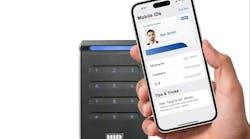Wireless Locks: Going Beyond the Perimeter
In recent years, we have seen gradual adoption of wireless locks and card readers in the commercial and industrial security market segments. The benefit of these devices is easy to see: decreased cost per opening, decreased infrastructure investment in conduit and wiring, and increased flexibility of deployments and modifications.
Industry pillars ASSA ABLOY and Allegion have each introduced fully wireless product lines, with a simple value proposition: if you want to stretch security capital budget dollars (and who doesn’t), you can simply control more doors per dollar with a wireless solution. Many of these wireless solutions also incorporate mobile credentials through Bluetooth or NFC-enabled devices – further pushing adoption in other areas, such as hospitality and visitor management.
But what about outside the building perimeter? Utility companies have hundreds of sites in remote areas that are often difficult to monitor and control. Further, a recent trend has been to open reservoirs for limited recreation and fishing. How can we hope provide access control at all of these locations without a costly wired solution that involves solar power and conduit trenching? Other applications, such as trucking, roadside equipment cabinets, municipal recreation areas and storage facilities also beg for this type of solution; in fact, there are dozens of applications that come to mind – and all of them would seem to enhance the value proposition of wireless locks in general.
Case in Point: Remote Sites
On a recent project, we were tasked with coming up with a wireless padlock solution to accommodate hundreds of remote sites – most of which require occasional access by operations and maintenance employees. Some of the sites require seasonal access to a limited population of non-employees, all of whom had historically been given a new key every year.
The end-user expressed a strong desire to not issue traditional access cards to each of these users due to cost. They explained that they needed an outdoor version of the newer hotel locks that enable a person to seamlessly enter through the use of a mobile app.
I was certain that my client was not alone in facing this challenge and that surely a number of wireless outdoor padlocks must exist in the marketplace; however, a survey of the major wireless lock manufacturers did not confirm my suspicions. At least one product from a well-known manufacturer exists in the marketplace, but it does not (currently) communicate over Bluetooth, and NFC-only solutions can be problematic, as they prohibit iPhones (Apple only recently agreed to open their iPhone NFC capabilities to outside development).
I may have been able to use a more traditional lock setup, but this would have required major modifications to existing fences and gates, and most commercially available wireless locks are not rated for long-term outdoor use. Other Bluetooth padlocks exist that target the consumer market (think gym lockers and tool sheds), but those products cannot be managed or monitored centrally.
The Solution
I found a solution from Salt Lake City-based Nokē (pronounced “no key”) – a newer entrant to the security market – who has introduced a hardened, outdoor IP66-rated Bluetooth padlock targeted at the enterprise market. Access to the offline lock is through a standard Nokē app, available in both iOS and Android. Privileges are set through a cloud-based control and monitoring application, which also enables users to quickly monitor lock data such as number of uses, most common users, and last known battery status.
Every time a user connects to a padlock, the app itself transmits data to the cloud through the mobile device, including transaction records and padlock battery level. If the user is in an area that does not have viable cellular coverage, offline access can be granted (i.e., the key can be downloaded to the phone so the user can unlock the padlock at a remote site without connectivity). Nokē also provides a Bluetooth fob that can be provisioned similar to a phone. Online lock models allow users to interrogate and provision the lock in real time.
Revoking privileges to a lock is as simple as changing a user’s privileges or removing them from the access group. The company also has an API available for those looking to develop a custom mobile application or integrate the locks into an enterprise access control system.
“Our solution is helping businesses all over the world simplify their method for key management and access control, while also providing them with tools to better manage their day-to-day work,” explains Hugh Olmstead, Nokē’s Business Development Director. “Our lock hardware is durable enough to be used in extreme environments, and our cloud-connected platform gives our users the capability to customize access and receive automated audit trails, providing a greater level of control and insight. The combination of heavy-duty hardware and sophisticated software makes Nokē a unique platform suited to fit the needs of companies in every industry from utilities to manufacturing to transportation and beyond.”
As the proliferation of wireless locking and access control continues in the security market, one can hope that other manufacturers will introduce similar niche offerings that will enable integrators to secure previously problematic areas without major infrastructure upgrades. With Bluetooth-enabled products like HID’s mobile access credential and ASSA ABLOY’s VingCard hotel room locks have already helped prime the larger population to use their phones as a credential, the future for mobile access seems limitless.
Brian Coulombe has joined Ray Coulombe as a joint columnist for the monthly Tech Trends article. Brian Coulombe is Principal and Director of Operations at DVS, a division of Ross & Baruzzini. He can be reached at [email protected], through Linked in at www.linkedin.com/in/brian-coulombe, or on Twitter, @DVS_RB.





